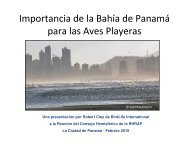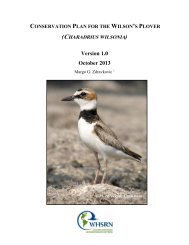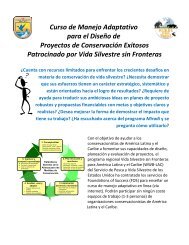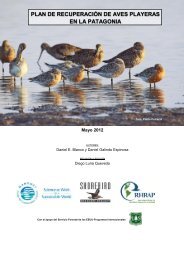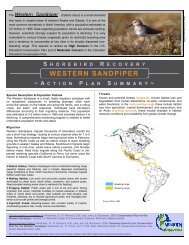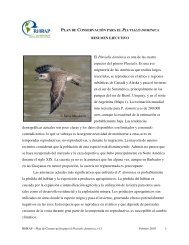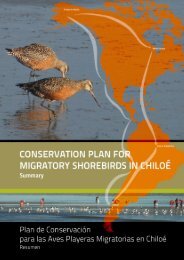Sanderling Plan - Western Hemisphere Shorebird Reserve Network
Sanderling Plan - Western Hemisphere Shorebird Reserve Network
Sanderling Plan - Western Hemisphere Shorebird Reserve Network
You also want an ePaper? Increase the reach of your titles
YUMPU automatically turns print PDFs into web optimized ePapers that Google loves.
identify shorebirds, how to manage habitat for shorebirds, and how to better manage human and<br />
other disturbance (e.g., vehicles, joggers, fishers, walkers, photographers, bird watchers, watersport<br />
recreationalists, pet owners, etc.), especially through outreach and effective partnerships.<br />
Several examples of suggested educational opportunities for visitors (e.g., in the North<br />
Atlantic Region; Clark and Niles 2000), some of which may also reduce human disturbance,<br />
include: providing viewing platforms (informative plaques, spotting scopes); providing onsite<br />
outreach at shorebird concentration areas (to minimize impacts by recreational viewers and<br />
wildlife watchers); and providing educational information on shorebirds, including links to<br />
online information (e.g., to <strong>Western</strong> Atlantic <strong>Shorebird</strong> Association, WASA – a website for<br />
shorebird-based info; or to the <strong>Shorebird</strong> Sister Schools Program (SSSP)). Other ways of<br />
addressing the community in general include informational flyers, birding trips, presentations<br />
within the community, outreach at local environmental fairs, and articles in newspapers and<br />
newsletters.<br />
In all of these cases, it is most meaningful when the public is actively engaged in<br />
activities that involve caring for wildlife and wildlife habitat – such as inviting the public to help<br />
keep track of shorebirds (i.e., citizen science), helping clean up local beaches, facilitating schools<br />
in coastal areas to establish “sister school” relationships with children in other coastal<br />
communities (or states/countries) based on sharing <strong>Sanderling</strong>s, and so on. Although passive<br />
information is beneficial and has the advantage of reaching a wider audience, active investment<br />
of one’s time and energy can shift attitudes on a deeper level and build a more permanent<br />
support base for the temporary inconveniences managers must ask the public to endure (such as<br />
beach closures). Annually organized shorebird-related events (e.g., shorebird/waterbird festivals,<br />
during migration) are excellent opportunities for raising awareness and building public<br />
involvement in and support for wildlife. This is also a good opportunity for connecting people<br />
and spreading interest/values across a diverse community, as well as connecting people that<br />
might not ever attend a bird festival). For example, organizers could invite businesses that might<br />
benefit from a temporary increase in visitors (e.g., book stores, photographic equipment store,<br />
latte stands, etc.) to highlight or associate their products with an upcoming or ongoing bird<br />
festival.<br />
WHSRN – <strong>Sanderling</strong> Conservation <strong>Plan</strong>, February 2010, v1.1 52




